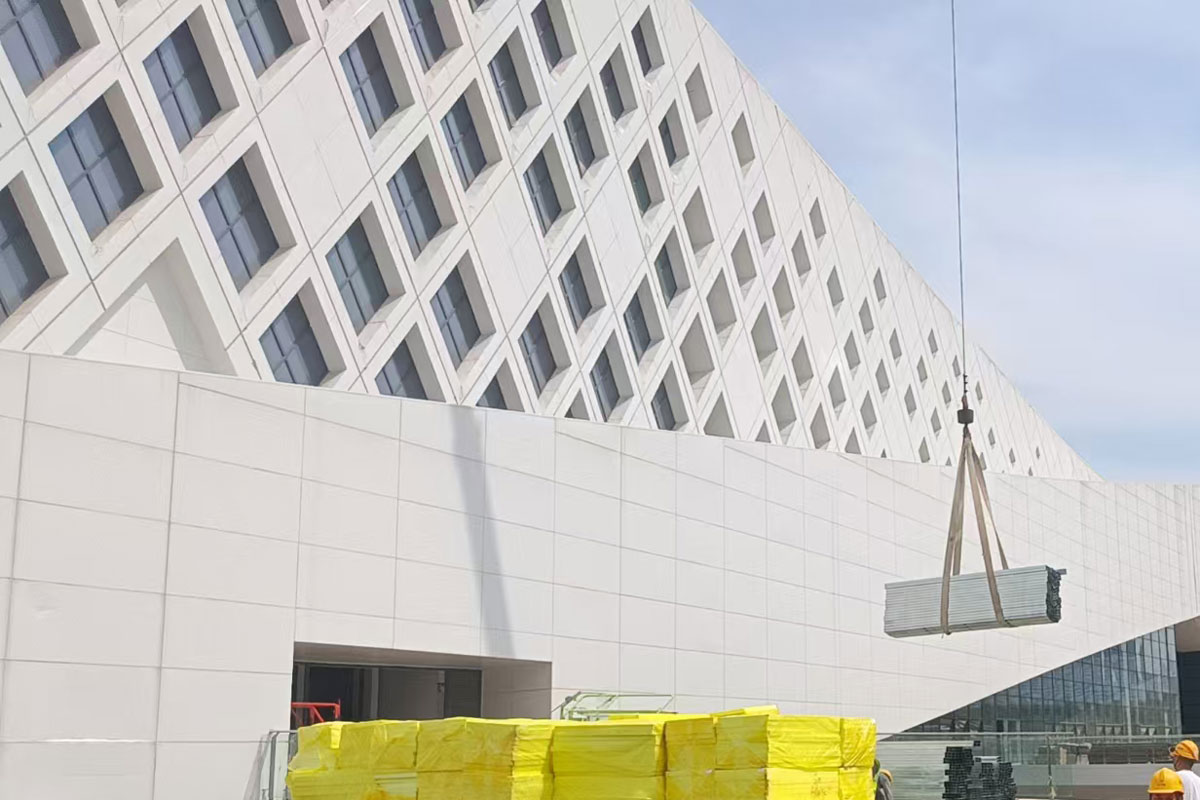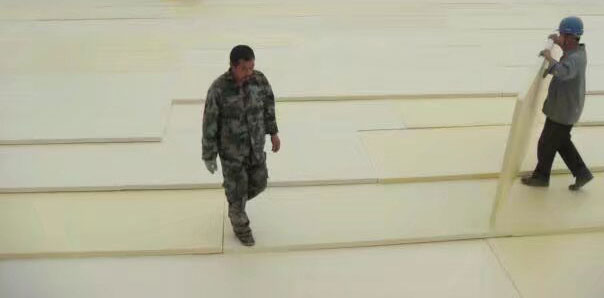Long-term commitment to the R & D and manufacturing of extruded board insulation materials, a new service platform
Production workshop feeding volume per hour 2 tons, daily output 1000 cubic meters

Extruded sheet for steel roof is a building material specially designed for thermal insulation, heat insulation and moisture resistance of steel roof. The following is a detailed introduction about it:
1. Characteristics
1. Excellent thermal insulation performance: The extruded board uses polystyrene as the main raw material and has a low thermal conductivity. In addition, the unique extrusion and extrusion process forms a tight honeycomb structure, which can more effectively prevent heat conduction and significantly reduce the heat transfer of steel structure roofs, keep indoor temperatures stable, and reduce energy consumption of HVAC equipment such as air conditioners.
2. High strength and compressive resistance: It has high compressive strength and impact resistance. Depending on different models and thicknesses, the compressive strength can reach more than 150-550Kpa. It can withstand various loads during the construction and use of the steel structure roof., such as walking of people, placement of roof equipment and possible snow weight, are not easy to deform or damage, ensuring the stability of the roof structure.
3. Excellent moisture-proof and waterproof performance: Its closed-cell structure makes it extremely low water absorption, excellent moisture-proof and anti-penetration properties, which can effectively prevent rainwater and moisture from penetrating into the interior of the steel structure roof, avoid rust and corrosion of the roof steel structure due to moisture, and Problems such as degradation of insulation performance caused by moisture in the insulation layer extend the service life of the roof.
4. Anti-corrosion and durability: It has excellent anti-corrosion and anti-aging properties. It can still maintain its excellent performance under high water vapor pressure. The service life can reach 30-45 years. It can maintain stable performance under different environmental conditions., suitable for steel structure buildings in various climates and environments.
5. Convenient construction: The texture is light and easy to cut, transport and install. It can be flexibly cut according to the shape and size of the steel structure roof, which can effectively improve construction efficiency, shorten construction period, and reduce construction costs.
6. Good environmental protection performance: High-quality extruded boards have been tested by relevant national departments to have stable chemical properties, do not volatilize harmful substances, and are harmless to the human body. The production raw materials can be environmentally friendly materials, which will not produce any industrial pollution and meet the development requirements of green buildings.

2. Type
1. Classification by compression strength and skin: Can be divided into X150 (Compression strength ≥150kPa, with skin), X200 (Compression strength ≥200kPa, with skin), X250 (Compression strength ≥250kPa, with skin), X300 (Compression strength ≥300kPa, with skin), X350 There are ten types including (compressive strength ≥350kPa, with skin), X400 (compressive strength ≥ 400kPa, with skin), X450 (compressive strength ≥450kPa, with skin), X500 (compressive strength ≥500kPa, with skin), W200 (compressive strength ≥200kPa, without skin), W300 (compressive strength ≥300kPa, without skin).
2. Classified by edge structure: There are mainly four types: SS flat-head products, Si products (lap joint), TG products (mortise and groove), and RC products (rain groove).
3. Construction Points
1. Roof base treatment: Before laying extruded boards, the surface of the steel structure roof needs to be cleaned to remove dust, debris, oil, etc. to ensure that the surface is smooth, dry and free from rust.
2. Laying a moisture-proof layer: Lay a moisture-proof layer, such as waterproof membrane or moisture-proof membrane, on the cleaned roof surface to enhance the moisture-proof performance of the roof. The moisture-proof layer should be laid flat and closely fitted to the steel roof.
3. Installation of fixing parts: Install fixing parts on the roof, such as expansion bolts, self-tapping screws, etc., according to the specifications of the extruded board and the roof area. The spacing of fixing parts should be reasonably set according to the size of the extruded board and the bearing capacity of the roof.
4. Laying extruded boards: Lay the extruded boards on the roof in predetermined positions. During laying, attention should be paid to the gap between the extruded boards to be as small as possible and to arrange them in a staggered manner to reduce the channels for heat transfer and moisture penetration.
5. Fixing the extruded board: After the extruded board is laid, fix it to the roof with fasteners. The fasteners should pass through the extruded board and tighten onto the steel structure of the roof to ensure that the extruded board is firmly fixed to the roof.
6. Treatment of plate joints: For the gaps between extruded plates, special sealant or tape can be used for sealing treatment to prevent the penetration of water vapor and air.
7. Covering protective layer: Cover the extruded board with a protective layer, such as cement mortar, metal plate, color steel plate, etc., to protect the extruded board from external factors, and also have an aesthetic effect.
1. Characteristics
1. Excellent thermal insulation performance: The extruded board uses polystyrene as the main raw material and has a low thermal conductivity. In addition, the unique extrusion and extrusion process forms a tight honeycomb structure, which can more effectively prevent heat conduction and significantly reduce the heat transfer of steel structure roofs, keep indoor temperatures stable, and reduce energy consumption of HVAC equipment such as air conditioners.
2. High strength and compressive resistance: It has high compressive strength and impact resistance. Depending on different models and thicknesses, the compressive strength can reach more than 150-550Kpa. It can withstand various loads during the construction and use of the steel structure roof., such as walking of people, placement of roof equipment and possible snow weight, are not easy to deform or damage, ensuring the stability of the roof structure.
3. Excellent moisture-proof and waterproof performance: Its closed-cell structure makes it extremely low water absorption, excellent moisture-proof and anti-penetration properties, which can effectively prevent rainwater and moisture from penetrating into the interior of the steel structure roof, avoid rust and corrosion of the roof steel structure due to moisture, and Problems such as degradation of insulation performance caused by moisture in the insulation layer extend the service life of the roof.
4. Anti-corrosion and durability: It has excellent anti-corrosion and anti-aging properties. It can still maintain its excellent performance under high water vapor pressure. The service life can reach 30-45 years. It can maintain stable performance under different environmental conditions., suitable for steel structure buildings in various climates and environments.
5. Convenient construction: The texture is light and easy to cut, transport and install. It can be flexibly cut according to the shape and size of the steel structure roof, which can effectively improve construction efficiency, shorten construction period, and reduce construction costs.
6. Good environmental protection performance: High-quality extruded boards have been tested by relevant national departments to have stable chemical properties, do not volatilize harmful substances, and are harmless to the human body. The production raw materials can be environmentally friendly materials, which will not produce any industrial pollution and meet the development requirements of green buildings.

2. Type
1. Classification by compression strength and skin: Can be divided into X150 (Compression strength ≥150kPa, with skin), X200 (Compression strength ≥200kPa, with skin), X250 (Compression strength ≥250kPa, with skin), X300 (Compression strength ≥300kPa, with skin), X350 There are ten types including (compressive strength ≥350kPa, with skin), X400 (compressive strength ≥ 400kPa, with skin), X450 (compressive strength ≥450kPa, with skin), X500 (compressive strength ≥500kPa, with skin), W200 (compressive strength ≥200kPa, without skin), W300 (compressive strength ≥300kPa, without skin).
2. Classified by edge structure: There are mainly four types: SS flat-head products, Si products (lap joint), TG products (mortise and groove), and RC products (rain groove).
3. Construction Points
1. Roof base treatment: Before laying extruded boards, the surface of the steel structure roof needs to be cleaned to remove dust, debris, oil, etc. to ensure that the surface is smooth, dry and free from rust.
2. Laying a moisture-proof layer: Lay a moisture-proof layer, such as waterproof membrane or moisture-proof membrane, on the cleaned roof surface to enhance the moisture-proof performance of the roof. The moisture-proof layer should be laid flat and closely fitted to the steel roof.
3. Installation of fixing parts: Install fixing parts on the roof, such as expansion bolts, self-tapping screws, etc., according to the specifications of the extruded board and the roof area. The spacing of fixing parts should be reasonably set according to the size of the extruded board and the bearing capacity of the roof.
4. Laying extruded boards: Lay the extruded boards on the roof in predetermined positions. During laying, attention should be paid to the gap between the extruded boards to be as small as possible and to arrange them in a staggered manner to reduce the channels for heat transfer and moisture penetration.
5. Fixing the extruded board: After the extruded board is laid, fix it to the roof with fasteners. The fasteners should pass through the extruded board and tighten onto the steel structure of the roof to ensure that the extruded board is firmly fixed to the roof.
6. Treatment of plate joints: For the gaps between extruded plates, special sealant or tape can be used for sealing treatment to prevent the penetration of water vapor and air.
7. Covering protective layer: Cover the extruded board with a protective layer, such as cement mortar, metal plate, color steel plate, etc., to protect the extruded board from external factors, and also have an aesthetic effect.